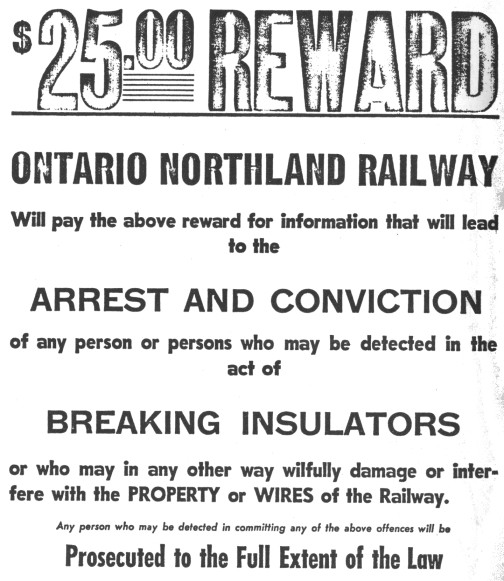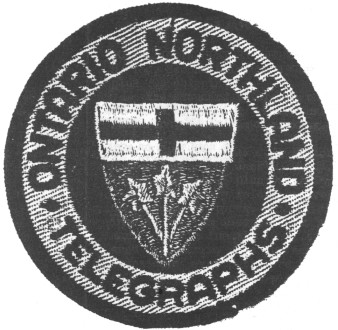Foreign Insulators
by Marilyn Albers
Reprinted from "INSULATORS - Crown Jewels of the Wire", August 1983, page 5
The Temiskaming and Northern Ontario Railway
(T. & N. O. Ry.)
The Temiskaming (also Timiskaming) and
Northern Railway is the original name of the Ontario Northland Railway which
runs from North Bay to Moosonee on James Bay. It was established in 1902 at the
March 17th session of the Legislature with the passing of the Temiskaming and
Northern Ontario Railway Act. Royal assent was also given at this time. The
"first sod" was turned and actual construction began October 14, 1902.
The 450 miles of track were completed to Moosonee and the "last spike"
driven on July 15th, 1932. The name was changed to Ontario Northland Railway in
1945 and remains so today.
Up until about a year ago collectors were generally
unaware that there was anything published and available to them about this
Canadian railway line. It was known, however, that B-hive shaped porcelain
insulators marked T. & N. 0. Ry. had been used on the telegraph line along
this railroad, even though very few had been found or were in collections. This
meant they were rare! Then, little by little, through letters I received from
Oscar Chaput (Wheatley, Ontario) some facts began coming to light. Oscar has
become an avid researcher of Canadian railway history during the past few months
and gladly shares with us what information he has. With his permission I will
quote from his earlier letters to me:
|
Oct.-Nov. 1982
"I understand from
Jack Tod that he sent you my letter regarding some white porcelain insulators I
obtained during the summer. I am very interested in finding out as much as
possible about these insulators, including the manufacturer, date of
manufacture, and possible value.
"On a recent trip to northern Ontario I
came across them in an antique shop in Powassan, a small community just south of
North Bay. The shop owner had worked for the T. & N. 0. Ry. years ago and
came into possession of these insulators only because of his involvement with
the company and his interest in antiques. As far as he is aware, very few other
insulators of similar size or marking were ever available or easily accessible.
I am an avid antique collector, including insulators, and I generally go to
shops, shows and flea markets in any area I am visiting. I have never seen these
insulators any other place from Detroit to Sault Ste. Marie across to Ottawa and
along the St. Lawrence and Lake Ontario to Toronto and any place in between.
They may not be rare, but they seem to be definitely scarce!
"The
insulators are B-hive shaped (and is our U-1131). They are white glazed
porcelain with a green ink marking on the skirt -- T. & N. 0. Ry. The wire
groove is 1-1/4" from the base, and the marking is halfway between the base
and wire groove. As you can see, from my rough sketch, the periods are square,
and the y in Ry is a lower case letter with a short tail on the end. There is
also an impressed 36 on the inside of the skirt just below the threads. Could
this be the year of manufacture?"
|
A drawing of U-1131 and the marking is
shown on the page following.
Jack Tod had been able to give him a brief history
of the T. & N. 0. Railway, but no information on the possible manufacturer
of these insulators, nor could I.
Now let's go back to the article on the B-hive
shaped A.E.R. insulators in the May '83 issue of Crown Jewels. Notice the same
square periods on this marking? We aren't sure yet who made these insulators,
either. The A.E.R. letters are of the same dull green as T. & N. 0. Ry. I
have now actually held both insulators in my hands, and the fact that the
"R's" are identical almost seems too obvious to have been a
coincidence! And both are of the same exact shade of green. I also have a U-1131 marked C.P.R. (dome). Same square periods, same formation of the R, same
shade of green. All three insulators have the same glistening white glaze-like
fine china! The C.P.R. and T. & N. 0. Ry. insulators both have an incuse 36
up inside the skirt near the pinhole. Unfortunately for my theory, at least in
part, the A.E.R. B-hive has no number incused there. But are these dates of
manufacture? Irregardless, it does appear that all three of these insulators
could have come from the same manufacturer! We know for sure that Pittsburgh
High Voltage Insulator Co. made the C.P.R. insulator. Did it also make the other
two? Listen to what Jack Tod has to say concerning the Pittsburgh dump in Derry,
Pennsylvania. Quoting from the second edition of his book Porcelain
Insulators:
"I managed to locate a landfill sight in Derry quite remote from the plant
where Pittsburgh had done their dumping for a number of years ... The dump had
numerous specimens of foreign styles and a variety of B-hive shapes with C.P.R.
and C.N.R . (Canadian railroads) markings." Further on he says,
"Pittsburgh High Voltage Insulator Co. catalogued a very large number of
pintype styles, more than any other company, and tended to go after the
"short order" business that other companies really didn't care for.
They not only made many types of special designs for customers and applied
customer markings on many different items, but they also made foreign styles for
export overseas and quite a variety of B-hive and other styles for Canadian
railroad companies...Virtually all Pittsburgh insulators have unglazed pinholes,
the top of which is either (1) perfectly flat or (2) some combination of
concentric circles ... I have never seen insulators of any other manufacture
having this Pittsburgh feature."
So guess what?? All three insulators,
C.P.R., A.E.R., and T. & N. 0. Ry., have unglazed pinholes which are
perfectly flat at the top! If PHV made all three of these, that's pretty strong
support. Also compare all three markings together as shown below:
However,
that's too easy. Listen to what Oscar had to report in his letter of April 15,
1,983:
|
"I have just received a very interesting letter from Mr. Lorne
Fleece, Telecommunications Maintenance Foreman for the ONR in Cochrane, Ontario.
Mr. Fleece has searched the records regarding insulators purchased for use along
the T. & N. 0. Ry. lines. He cannot find, nor has he heard of, any
insulators purchased from the Pittsburgh High Voltage Co. of Pennsylvania.
According to the best sources at his disposal, the T. & N. 0. Ry. white
porcelain insulators were made before 1914 in Europe. Unfortunately no other
information is yet available. I am going to continue looking into this matter,
however. Mr. Fleece did send along to me copies of company catalogues from which
the ONR has and continues to purchase glass insulators." |
These sheets did
show that both Automatic Electric Co. and Northern Electric Co. supply C.D.'s
106, 128 and 154 for telecommunication use, and Northern Electric supplies the
supporting hardware as well. I'm assuming these companies are Canadian suppliers
only (not manufacturers) of glass insulators, probably from Dominion Glass Co.
Oscar's May l4th letter says:
|
"I have received additional information which
seems to support the idea that the insulators (T. & N. 0. Ry.) may have been
made in England, but no proof. In spite of the easy access from the U.S., it
seems that Canada did import a great many porcelain insulators from England over
a period of time."
|
Yes, Oscar, you're right! In fact, the Buller Jobson
& Co. catalogue (1890-95 London, England) offered two sizes of B-hives made
for export to Canada: U-1135 called "Gisborne's Canadian" and U-1123
called "Gisborne's Pattern, small". I realize these are slightly
different from U-1131, but even so, it does prove that some Canadian used
insulators originated in England. We'll keep searching for the answers and let
you know when and if we learn anything further. The Bullers items are shown
below as they appeared in that early catalogue, and also as they are
represented, Jack Tod fashion, in the book "Worldwide Porcelain
Insulators" published in 1982.
Also shown are two additional items of
interest sent to Oscar From Mr. Fleece.
The first one is a copy of a linen reward sign which is used by the ONR in Northern Ontario and would certainly
make an interesting "go-with".
The second one is a copy of an old
telegraph patch worn by the messengers of the ONR. The red and white cross of
St. George represents Ontario's original ties with Great Britain, and the three
maple leaves are symbols of Canada.

Large Image (148 Kb)

|
